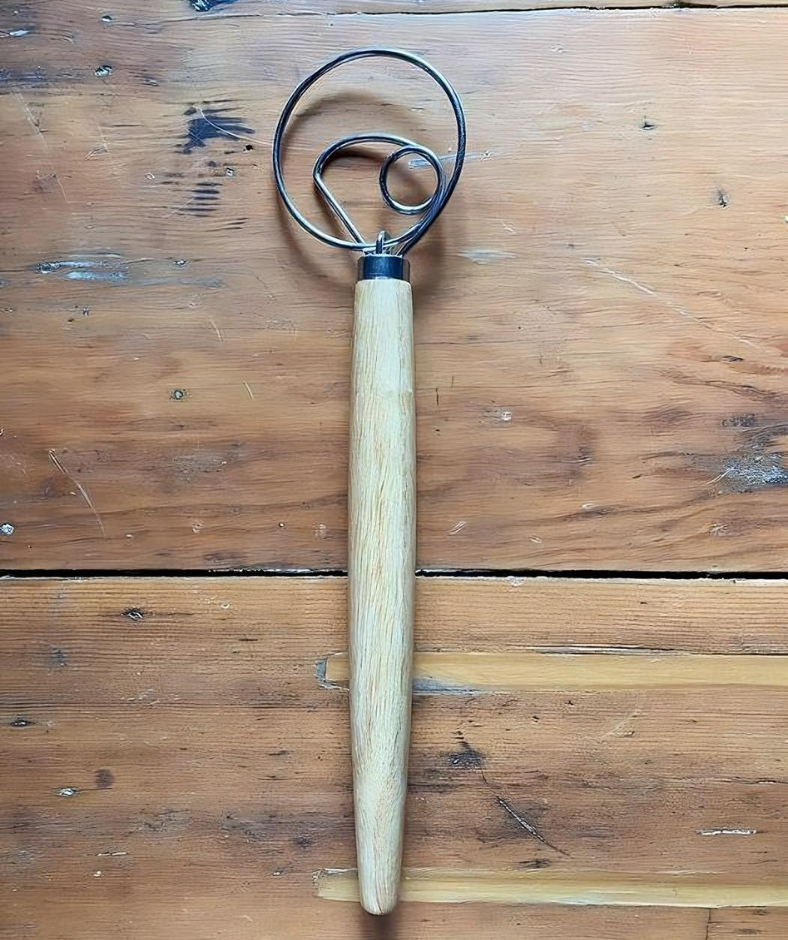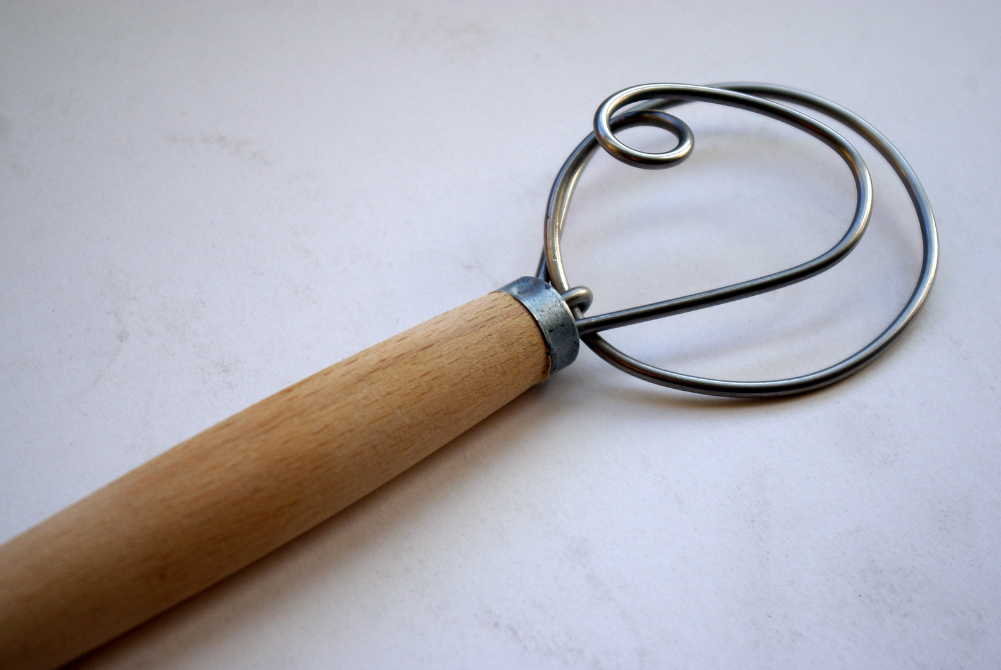The Danish dough whisk is more than just a kitchen utensil—it’s a piece of Denmark’s rich culinary heritage. For centuries, Danish bakers have relied on this simple yet highly effective tool to create some of the finest breads and pastries. With its distinctive design and unique functionality, the Danish dough whisk has found a cherished place not only in Scandinavian kitchens but also in households worldwide. This traditional baking tool, first crafted in the early 20th century, remains a staple for home bakers who appreciate the art of bread-making.
The Origins of the Danish Dough Whisk

The story of the Danish dough whisk traces back to early 20th-century Denmark, a time when baking was more than a necessity—it was a cultural expression. With the rise of home baking and a focus on artisanal techniques, bakers needed a tool that could blend ingredients efficiently without overworking the dough.
Enter the Danish dough whisk, a deceptively simple tool designed to help create light, airy loaves while preserving the dough’s texture. Featuring a long wooden handle and a looped wire head, this tool was crafted for one purpose: to make dough mixing easier while maintaining the quality of the bread. Its popularity quickly spread, and soon it became a staple in many Scandinavian kitchens.
Why the Danish Dough Whisk Works So Well
What makes the Danish dough whisk so special? Unlike traditional whisks or spatulas, this tool features a unique open-wire loop design that allows it to cut through thick doughs effortlessly. This looped head is ideal for mixing both wet and dry ingredients, as it minimizes clumping and prevents overdevelopment of gluten—a common issue that can result in tough, chewy bread.
The whisk’s wooden handle offers a comfortable grip and excellent leverage, making it easy to use for long mixing sessions. Its ergonomic design allows for an efficient, one-handed mixing technique, ensuring the dough is perfectly incorporated without overexerting your wrist. This design also makes it versatile enough to handle everything from rustic sourdough and pizza dough to cookie batter and pancake mix.
How to Use the Danish Dough Whisk for Perfect Results
Using the Danish dough whisk is simple, yet its effectiveness is undeniable. Here’s how to make the most of this classic tool:
- Prepare Ingredients: Begin by placing your dry ingredients (like flour, salt, and yeast) into a mixing bowl. Add your wet ingredients (water, milk, or eggs) as needed.
- Mix Efficiently: Hold the whisk at a slight angle and start combining the ingredients. The open loops of the whisk will allow you to cut through the mixture, ensuring even incorporation without creating lumps.
- Achieve the Right Consistency: The whisk’s design prevents excessive gluten development, ensuring that your dough remains soft and elastic.
- Clean Up Easily: Unlike traditional whisks, dough doesn’t get stuck in the wires of the Danish dough whisk. Simply rinse it under warm water, and any dough residue will slide off, making cleanup quick and easy.
This whisk isn’t just for bread—it’s also ideal for mixing batters for muffins, cakes, and even thick cookie doughs. Its versatility and ease of use make it an essential tool for any baking enthusiast.
The Resurgence of the Danish Dough Whisk in Modern Kitchens
Despite the flood of modern kitchen gadgets, the Danish dough whisk has remained a favorite among both novice and professional bakers. Its simplicity and effectiveness have led to a resurgence in recent years, particularly among those who value the artisanal approach to baking. With the rise of the homemade bread movement and a return to traditional cooking methods, this whisk has become a symbol of authentic, hands-on baking.
Part of the whisk’s appeal lies in its tactile nature. Unlike electric mixers that detach bakers from the process, the Danish dough whisk invites users to feel the dough, engage with the ingredients, and enjoy the rhythm of manual mixing. It’s this human connection to the craft of baking that has helped the whisk maintain its popularity in an age of automation.
Why the Danish Dough Whisk Is Passed Down Through Generations

The Danish dough whisk is more than just a tool—it’s often seen as a family heirloom, passed down from one generation to the next. For many bakers, it symbolizes not only a connection to the past but also the continuation of cherished family traditions. It’s the same whisk that made Grandma’s famous sourdough, mixed Dad’s beloved pizza dough, and created countless batches of cookies on a rainy day.
Its sturdy construction and timeless design ensure that it can last for years, if not decades, with proper care. Many modern versions are still crafted with the same attention to quality, featuring durable wire loops and handles made from sturdy wood. This enduring craftsmanship allows the whisk to hold its place in both traditional and contemporary kitchens.
Legacy and Influence on Modern Baking Tools
The impact of the Danish dough whisk extends beyond its own usage—it has influenced the design of many modern kitchen tools. From spiral whisks to hybrid mixing devices, many contemporary tools draw inspiration from the Danish dough whisk’s efficiency and simplicity. These new designs aim to replicate the ease of use and effectiveness of the original whisk, proving that good design never goes out of style.
While modern appliances may offer speed and automation, the Danish dough whisk remains unmatched for its ability to create high-quality doughs and batters with a more hands-on, artisanal touch. It’s a tool that encourages bakers to slow down, enjoy the process, and connect with the craft of baking—one loaf at a time.
Conclusion: The Enduring Legacy of the Danish Dough Whisk
The Danish dough whisk stands as a testament to the timeless principles of good design and functionality. With its simple yet effective design, it continues to inspire bakers around the world who appreciate the art of traditional baking. Whether it’s used to craft a rustic loaf of sourdough, a batch of homemade cookies, or even pancakes on a Sunday morning, this whisk remains a beloved tool in kitchens everywhere.
In a world that often prioritizes speed and convenience, the Danish dough whisk reminds us that sometimes, the simplest tools offer the most rewarding experiences. So, next time you’re mixing up a batch of dough, reach for this classic tool and let it guide you back to the heart of baking—where tradition, quality, and a love for the craft come together in perfect harmony.



